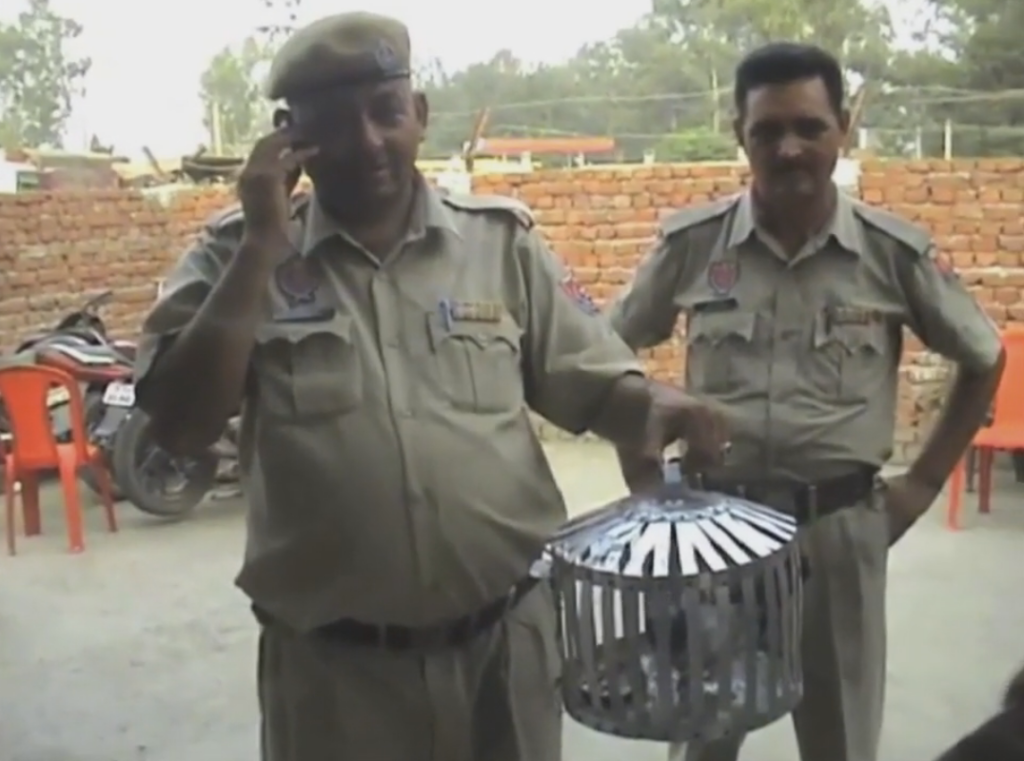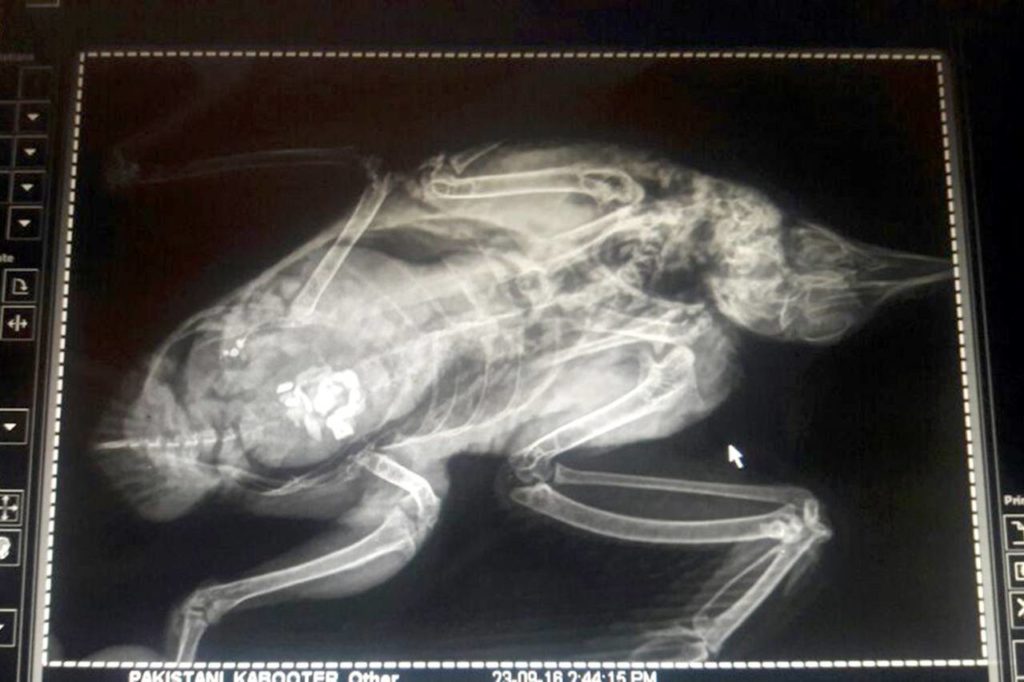
Policemen in Pathankot with the pigeon that has been detained on suspicion of terrorist links. Credit: Screen grab from rt.com
The nation is delighted to learn that the Punjab police successfully intercepted an airborne ‘terrorist’ threat to Prime Minister Narendra Modi on Monday. The avian intruder is said to have emerged as an innocuous grey speck on the horizon but its sinister nature revealed itself soon enough when it became apparent that the pigeon was carrying a note tied to its leg.
The authorities believe he flew from Pakistani territory across the border to Pathankot – site of an attack on an Indian airbase earlier this year – soon after India announced it had launched ‘surgical strikes’ on terrorist ‘launching pads’ across the Line of Control in Kashmir. According to various sources, the message the pigeon was carrying said “Modi, we’re not the same people from 1971. Now each and every child is ready to fight against India.”
The note was written in Urdu – an Indian language most police forces around the country don’t know how to read and which they are predisposed to believe is the language of choice for terrorists – and was signed by the Lashkar-e-Tayyaba. Reacting swiftly, the Punjab police immediately placed the suspect pigeon in custody.
Television channels have broadcast footage of the offending bird behind bars, watched over by uniformed policemen. The question being asked by intelligence agencies and police ‘sleuths’ – though not yet by angry mustachioed experts on television manel discussions – is whether this is a new tactic being developed by Pakistan. The fear is that pigeons are being trained and sent from specific launching pads across the border to India. Pathankot police officer Rakesh Kumar told AFP that police were “investigating the matter very seriously.” It is not immediately clear if the matter will be escalated to the cabinet committee on security for review.
Rakesh Kaushal, a senior superintendent of police in Punjab was quoted as saying, “We have checked the bird properly and thoroughly and found nothing to cause alarm.” He qualified his statement by saying that scans of the bird revealed no transmitters, cameras or espionage equipment. The next step, so as to avoid fanning the flames of another international incident, would be to feed the bird and then release it. Presumably with a tracking device to allow the Indian agencies to monitor its movement and identify who its ‘handlers’, if any, are.
According to the Wall Street Journal, the Punjab police detained another pigeon about ten days ago, “some 30 miles south of the more recent avian arrest.” This particular infiltrator did not carry a message but had ink-stained tail feathers with an 11-digit number and other markings in Urdu inscribed on its tail feathers. The police acted promptly, mobilising an Urdu expert to unravel the lettering, which turned out to be the days of the week. Said the WSJ:
The matter might have ended there, but a precautionary X-ray at a local clinic revealed some unusual spots in the bird’s abdomen. Two more X-rays followed, but Mr. Singh said authorities still aren’t sure if there is anything nefarious.
“We can’t understand what it is,” said Mr. Singh. The army is also being consulted, he said. The army hasn’t commented on the case.

Suspect pigeon subjected to full body x-ray. Credit: Punjab Police/WSJ
In 2015, the police in Modi’s home state of Gujarat “arrested” a pigeon and promptly launched an “anti-terror probe” after it was found loitering in a suspicious manner. According to the Hindustan Times:
A pigeon ‘detained’ with a chip on one leg, a ring with a code on the other leg and some writings on its wings near Indo-Pak coastal border in Gujarat has forced the local administration to inform the Union home ministry about its ‘mysterious’ landing.
According to a two-page report sent to the home ministry, the coast guard, forest department, forensic experts and state’s Anti-Terrorism Squad have all been asked to pitch in to examine the matter.
But since no conclusion could be drawn from the exercise, the probe into the mystery pigeon is still on, says the report.
The same year, another pigeon was detained in Punjab because it bore Urdu markings:
“We are investigating the matter and have alerted the Intelligence Bureau (IB) and the Border Security Force (BSF),” R K Kaushal, SSP, Pathankot told the Indian Express.
Even the senior officials of Border Security Force have “inspected” the bird.
“Nothing suspicious has been found as yet but we are not taking any chances,” BSF DIG R S Kataria said.
In 2002, at the height of the last major round of India-Pakistan tension, the police in Uttar Pradesh went public with their belief that Pakistan had created a flying insect to terrorise people. According to a Times of India report from Barabanki,
The mysterious flying object ‘muhnochwa’, which has created terror in the state, is a ‘technologically developed special insect’. It is brought in the country by anti-national elements.
This was stated by Deputy Inspector General of Police, Faizabad range, K.N.D. Dwivedi while addressing mediapersons here on Sunday. He said that the insect, measuring about six-inch, had been brought from outside the country.
Some anti-national elements were releasing these insects in villages and cities in the night just to create terror, he said claiming that the insect had been developed through a special technology.The DIG said that the police had launched a drive to nab these miscreants and the night patrolling had been intensified. The police had recently claimed that an insect, emitting red light from its eyes and blue from its rear, was killed here.
Scholars from universities like JNU and Mahendragarh would have us believe these frequent incursions are the result of pigeon homing being a popular hobby on both sides of the India-Pakistan border. But the nation must decide if its to be ‘India First’ or misplaced sympathy for terror suspects. At a time when even Pakistani artists working in India are being made to feel the heat, kabootar jihad cannot be expected to get off lightly.
